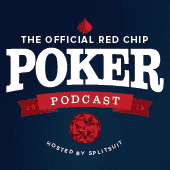The most popular poker strategy topics of 2016 are dissected with James “SplitSuit” Sweeney and host Zac Shaw in our first episode of the new year. Get a bead on where poker strategy is going in 2017 by reviewing last year’s successful strategies. The top-trafficked content of the year covered fixing poker leaks, playing more hands, hand reading and moving up. We riff on the strategic nuance to each aspect.

The Most Popular Poker Strategy Content in 2016
1. How to fix poker leaks
2. How to play more hands profitably
3. How to construct ranges
4. How to move up to the next level and go pro
Poker Goal Setting in 2017
Our SMART Goal Setting podcast drills down to the heart of the first topic on our first podcast of 2017: how to se effective goals using a tried-and-true method that applies to poker and any field beyond it.
Don’t set extremely lofty monetary goals. Your major focus isn’t the money. Your focus is making the best decisions over and over again, and not having the luck aspect completely screw you.
Focus on long-run goals but make them specific. Do you not 3-bet lite enough? Break down what needs to happen before that becomes an instinct instead of a dream.
SplitSuit talks about raising a teenager and helping him plan and set a schedule for the first time. Whether you’re a teenager or an adult, they key is to make things a habit. The worst thing you can do is set a big annual goal that isn’t build of recurring tasks. And moreover, set recurring tasks to evaluate where you’re at, and what you need to be studying to get better. Make studying consistent. You’re not going to cram it all in before the big game. Make it a daily or at least weekly habit that gets gut-checked often.
Don’t overload yourself in the beginning. It’s easy to do at the beginning. But once you get into the grind, you’ll realize setting aside 30 minutes is an enormous win. What you think you might be capable of in terms of study time may receive a reality check sooner than later.
Dynamic Ranges
Hand charts fail to offer the “why” for what you’re opening. That’s why a big theme in 2016 was “dynamic everything”, with ranges taking center stage. Getting away from static ideas in regards to opening ranges requires experience and skill building around information collection, but these are muscles you should be flexing by deviating from static strategies.
Understanding bare-bones hand reading and math can go a long way to informing your dynamic strategic direction.
Thinking in Ranges is something SplitSuit was all about in 2016, not the least of his projects was his hand reading workbooks and Hand Reading Lab, a definitive guide to a poker skill we all use in every hand we play.
Sweeney talks about “running Flopzilla in his brain” as a visual thinker. When he’s playing, he’s focused first and foremost about pre-flop open ranges. For example, having a 3-bet called by another player frequently caps their range and takes AA and KK out of their range.
When the flop comes, ask yourself how often that pre-flop open range hits the flop. It’s also worth considering how they’ll react to your actions, and what range they might be putting you on (if they are putting you on a range at all.)
Your hand reading won’t ever be perfect. But as you up the accuracy percentage, you up your win rate.
Poker Strategy Software
Sweeney and Shaw encourage listeners to check out the Red Chip Poker Best Poker Strategy Software article to read more about all the software platforms they talk about in the podcast.
Sweeney talks in detail about how he uses range visualization software to see how certain ranges hit certain flops. This helps you develop key exploitative strategies, lines that maximize profit, and an intuition about how ranges hit boards.
The pair also discuss GTO solvers, and how to benefit from having a basic understanding of game theory optimal strategies for poker. But, Sweeney cautions, don’t go out of balance as you learn the Nash Equilibirum strategies in critical spots. Exploitative play, particularly in unskilled and unstudied player fields, will often take you farther into the profit column that taking GTO too far. The exception is in very talented player fields.
AI poker instructors are also discussed as useful tools to gain experience in between sessions, though they have a long way to go to mimic good, aggressive games. Sweeney found that these AI bots were often easily exploited by finding their pain thresholds and jamming on the aggression.
Aggression Trends in Poker
Sweeney says, “The game is so beautiful because it’s always in flux.”
He’s observed the game has been growing more aggressive over time. He sees more aggression in the future as well, because as skill level increases, aggression tends to increase as well.
The poker ecosystem revolves around the plays which make opponents most uncomfortable. This is not necessarily limited to applying pressure, although it is a major component. Instilling doubt can sometimes be just as effective. For advanced players who are moving up in stakes, deviating from common strategies often presents itself as the most important counter-strategy to include in one’s arsenal.
